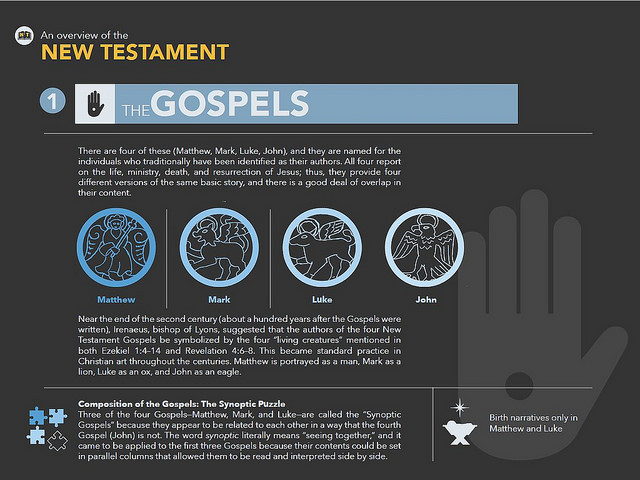Introducing the New Testament
A Historical, Literary, and Theological Survey
4. The Gospels
Chapter Intro Video
Chapter Objectives
This chapter should enable the student to
identify the basic genre of the Gospels as “ancient biographies” and to offer caveats that prevent such an identification from being misleading or simplistic.
describe the key features of five types of material found in the Gospels: parables, miracle stories, pronouncement stories, individual sayings, and narratives of Jesus’ passion and resurrection.
summarize what is meant by “the Synoptic Puzzle” (or “Synoptic Problem”) and diagram two important solutions that have been offered for this quandary.
report what scholars have proposed concerning the nature and origins of the Q source and indicate why this is significant for New Testament study.
Chapter Summary
The New Testament contains four Gospels that are not exactly like any other books known to us. In terms of genre, they are probably most similar to ancient biographies, but they contain various types of literature within their pages and also evince the influence of Jewish narratives found in the Old Testament. Furthermore, they differ from modern biographies in notable ways: they employ a fictive (“fictionlike”) style of narrative and they are overtly evangelistic.
The Gospels contain more than forty parables, which are stories or sayings of Jesus that have an illustrative or symbolic meaning to them. They also contain numerous accounts of Jesus working miracles—acts of extraordinary power that astonish onlookers. They contain “pronouncement stories,” which function as vehicles for preserving sayings of Jesus within memorable contexts, and they sometimes also report isolated sayings of Jesus that scholars seek to classify according to content or type. Finally, all four Gospels conclude with extended narratives of Jesus’ crucifixion and resurrection.
Much scholarly attention has focused on “the Synoptic Puzzle,” the question of how the first three Gospels (Matthew, Mark, and Luke) might be related to each other. The dominant theory suggests that the Gospel of Mark and another, now lost, work called the Q source were written first; Matthew used both Mark and Q as sources when composing his Gospel, in addition to some other material (called “M”); likewise, Luke used both Mark and Q when composing his Gospel, in addition to some other material (called “L”). Alternative theories dispense with Q altogether: one suggestion contends that Matthew wrote his Gospel first, that Luke used Matthew’s Gospel as a source, and that Mark produced his work last as a condensation of the other two; another holds that Mark’s Gospel came first, Matthew modified Mark, and Luke drew upon both Mark and Matthew.
Study Questions
Describe how each of the four Gospels presents a distinctive portrait of Jesus. For each Gospel, describe the image of Jesus that is presented more prominently and clearly in that one book than in any of the other three.
How did ancient biographies differ from modern ones? List five features of the Gospels that would have been typical for biographies at the time but would not be typical of biographies today.
Indicate at least three different ways that parables function within the Gospels.
How might a typical response to miracle stories in our modern world differ from a typical response to such stories in the world that produced the Gospels?
What is a “pronouncement story” and how do such stories function in the New Testament Gospels?
How does the story of Jesus’ passion and resurrection serve as a distinctive theological climax for each of the four Gospels in which it is related?
Diagram two solutions to “the Synoptic Puzzle” and indicate why this discussion is important for Gospel studies.
What is the Q source and what do scholars think it reveals about the interests or priorities of early Christianity?
Video: Later Images of Jesus
Widget: The Dying Words of Jesus
Click to compare the dying words of Jesus in Matthew and Mark, Luke, and John.
Widget: Suggested Solutions to the Synoptic Puzzle
Click to see how scholars think the Synoptic Gospel writers may have used sources in their Gospel composition.
Assets
-
Hyperlink 4.1. The Gospel: Four StagesDownload
-
Hyperlink 4.2. Literary Characteristics of ParablesDownload
-
Hyperlink 4.3. Parables as AllegoriesDownload
-
Hyperlink 4.4. What Happens When Jesus DiesDownload
-
Hyperlink 4.5. Proposed Solutions to the Synoptic PuzzleDownload
-
Hyperlink 4.6. Evidence to Support the Two-Source HypothesisDownload
-
Hyperlink 4.7. Evidence to Support the Farrer TheoryDownload
-
Hyperlink 4.8. Evidence to Support the Two Gospel HypothesisDownload
-
Hyperlink 4.9. The Q Source in Contemporary ScholarshipDownload
-
Hyperlink 4.10. Bibliography: The Gospels (General)Download
-
Hyperlink 4.11. Bibliography: Infancy NarrativesDownload
-
Hyperlink 4.12. Bibliography: ParablesDownload
-
Hyperlink 4.13. Bibliography: Miracle StoriesDownload
-
Hyperlink 4.14. Bibliography: Passion NarrativesDownload
-
Hyperlink 4.15. Bibliography: Resurrection Narratives<Download
-
Hyperlink 4.16. Bibliography: Individual Gospel CharactersDownload
-
Figure 4.6. Suggested Solutions to the Synoptic PuzzleDownload
-
Box 4.1. Four Pictures of JesusDownload
-
Box 4.2. Characteristics of Ancient BiographiesDownload
-
Box 4.3. Parables in the GospelsDownload
-
Box 4.4. Miracle Stories in the GospelsDownload
-
Box 4.5. Pronouncement Stories in the Gospels: Some ExamplesDownload
-
Box 4.6. Sayings of JesusDownload
-
Box 4.7. The Dying Words of JesusDownload
-
Box 4.8. Contents of Q: Material in Matthew and Luke but Not in MarkDownload



